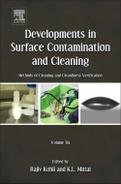Preface
The purpose of the book series Developments in Surface Contamination and Cleaning is to provide a continuous state-of-the-art critical look at the current knowledge of the behavior of both film-type and particulate surface contaminants. The first five volumes, published in 2008, 2010, 2011, 2012, and 2013, respectively, covered various topics dealing with the fundamental nature of contaminants, their measurement and characterization, and different techniques for their removal. This book is the sixth volume in the series.
The individual contributions in this book provide state-of-the-art reviews by subject matter experts on cleaning and cleaning verification.
Ionic liquids (ILs) and deep eutectic solvents (DES) are a new class of low melting point materials with unusual and unique properties that make them attractive for cleaning applications. In his first contribution, Rajiv Kohli discusses the characteristics of these solvents that include high solubility for a wide range of contaminants, thermal and chemical stability, low melting point (even below 273 K), very low volatility, and high conductivity. IL solvents do have some disadvantages including high cost, complex synthesis, need for purification for reuse, and high toxicity and nonbiodegradability of many formulations. Several DES formulations have been developed to overcome some of these limitations. Recently, cleaning applications have been proposed and have been successfully demonstrated, although many of these are largely still at the laboratory stage. The applications range from brush cleaning for removal of microcontaminants, semiconductor wafer and integrated circuit cleaning, precision cleaning of parts for aerospace applications, oxide-scale removal on metals, electropolishing of metals, microbial decontamination, cleaning of artworks, cleaning of wellbores in oil and gas recovery, soil decontamination, and consumer product applications.
Lirio Quintero and Norman Carnahan review the use of microemulsions for cleaning applications. The distinctive properties of microemulsions (high solubilization of oil, low interfacial tensions, and spontaneous formation) make these fluids very attractive for a variety of cleaning applications. Microemulsions have been used in industrial cleaning processes and household cleaning applications. Some of the applications include domestic and industrial laundry; cleanup of wastewater; cleaning of contaminated soil, fabrics and textiles, frescoes, paintings, monuments and building structures that have been polluted; and various applications in the oil and gas industry.
Cleaning processes will continuously be challenged because of the further scaling down of device structures and introduction of new materials and three-dimensional device features. Removal of these “killer” particle defects must be carried out without damage to these fragile features and with essentially zero material loss or roughening of exposed surfaces. The contribution by James T. Snow, Masanobu Sato and Takayoshi Tanaka discusses dual-fluid spray cleaning which offers high potential for removal of contaminant particles from various surfaces. The utilization of the forces created from the droplet impact phenomena from dual-fluid spraying has proven to be one of the more effective techniques for particle removal without damage in semiconductor wafer cleaning processing. The spray nozzle enables separate control of droplet diameter and velocity to provide optimized droplet energy. This has improved the cleaning efficiency and has reduced the potential for pattern damage caused by variations in droplet size and velocity.
The second contribution by Rajiv Kohli is an overview of microbial cleaning that takes advantage of naturally occurring microbes to remove a wide variety of contaminants from various surfaces. Microbial cleaning has been shown to be an effective alternative to conventional solvent cleaning for many applications. The method is based on the affinity of microbes for hydrocarbons which are digested, producing harmless carbon dioxide, water and soluble fatty acids. The microbes are nonpathogenic and are safe to handle and dispose. The process is environmentally friendly and is less expensive than solvent cleaning, but it is not applicable to high-precision cleaning applications. Typical applications include parts washing; oil and grease removal from concrete and other floor surfaces, and from drains and grease traps in manufacturing facilities, hospitals, restaurants, food processing facilities, and similar locations; cleaning of historical artworks and structures; cleaning and disinfection in health care facilities; wound debridement; controlling sulfate-reducing bacteria in oil fields; mercury bioremediation; and household and institutional cleaning applications.
Cleanliness verification is growing in its importance in many industries, such as aerospace, biomedical engineering, and semiconductor fabrication. Darren Williams and Trisha O’Bryon examine the utility of sessile drop contact angle measurement for surface energy determination and cleanliness verification. They review the available methods, commercial instruments, patents, and literature describing the state-of-the-art in contact angle measurement. This is followed by a description of contact angle measurement techniques that have been modified for use on large surfaces. The negative effects of these changes on accuracy and precision are discussed, and remedies are proposed, including the use of standard reference objects that mimic the size and shape of sessile drops. The combination of these validation tools and the modified contact angle measurement techniques fills a need for robust, production-line-capable cleanliness verification methods.
The contributions in this book provide a valuable source of information on the current status and recent developments in the respective topics on the impact, characterization and removal of surface contaminants. This book will be of value to government, academic, and industry personnel involved in research and development, manufacturing, process and quality control, and procurement specifications in microelectronics, aerospace, optics, xerography, joining (adhesive bonding) and other industries.
We would like to express our heartfelt thanks to all the authors in this book for their contributions, enthusiasm and cooperation. Our sincere appreciation goes to our publishers Frank Hellwig and Matthew Deans, who have strongly supported publication of this volume, in particular, and this series, in general. Renata Corbani and the editorial staff at Elsevier have been instrumental in seeing the book to publication. Rajiv Kohli would also like to thank the staff of the STI library at the Johnson Space Center for their efforts in expeditiously locating obscure and difficult-to-access reference materials.
Houston, Texas, USA
Hopewell Junction, New York, USA
A companion website for this book with all figures including color figures can be found at http://booksite.elsevier.com/9781437778793.
